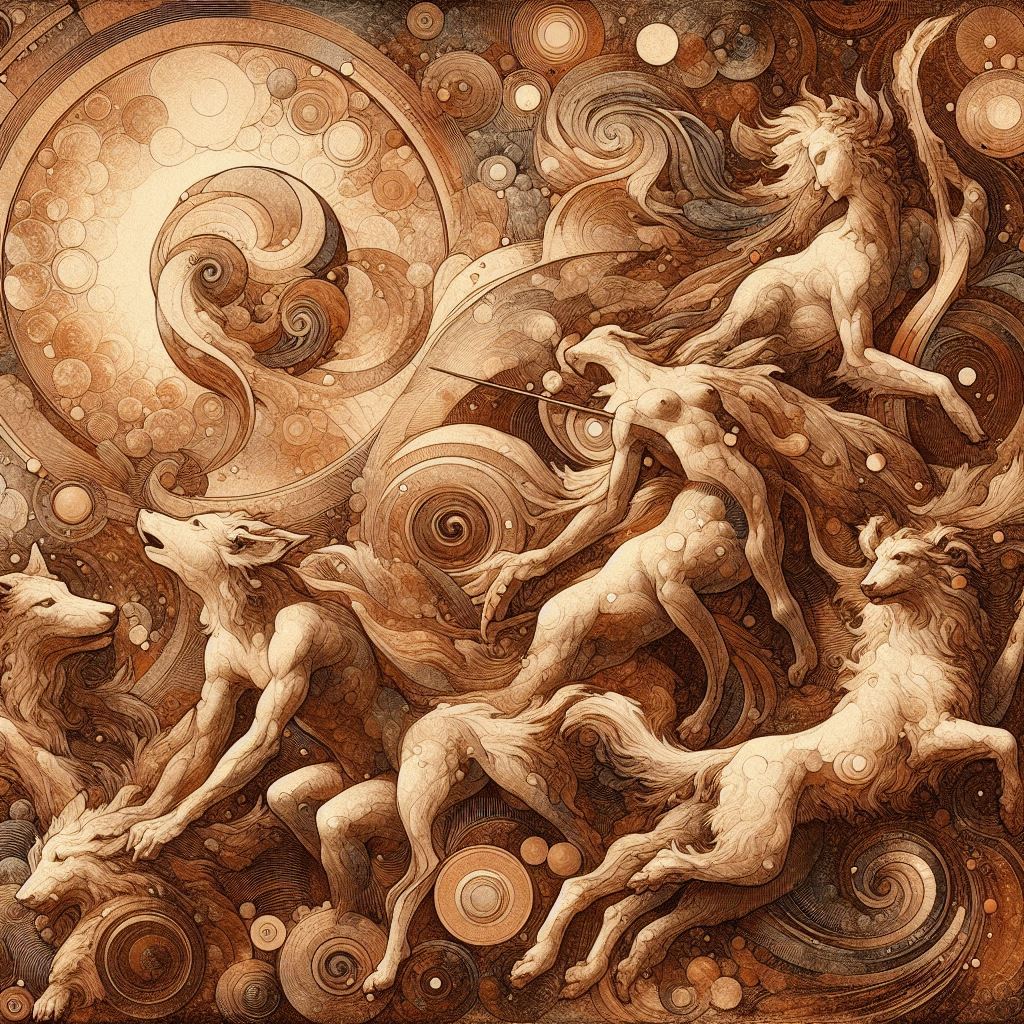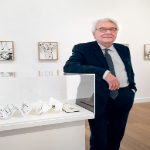TRANSLATED FROM THE FRENCH BY JOHN TAYLOR
Has it ever been noticed how much Titian loved dogs? I know nothing of his personal sentiments for his pets, nor whether he hunted wild game and fowl, but he definitely loved painting dogs. More than anyone else in his trade, he depicted a great number of furs and their shimmering effects.
It can be taken for granted that a dog, as a hunter’s attribute, is a mandatory figure in Actaeon’s Death (National Gallery of London). Aren’t the three greyhounds actors in the drama of which Diana is the organizer and Actaeon the victim?
This same is true of Diana and Callisto in Edinburgh. The big placid spaniel and the great greyhound lying down are legitimated by the bows and arrows carried by the following of the huntress who is in wrath against the nymph made pregnant by Jupiter’s doing.
But already in Diana and Actaeon in the same National Gallery of Scotland, the artist makes an addition. It is the bathing scene. Actaeon is followed by a spaniel, which is by no means abnormal. However, this curly-furred, bushy-tailed little dog, with its small black eyes, which bares its teeth and growls at Diana’s feet, on the other side of the stream, exists only to represent the fury of the goddess whose sense of decency has been startled.
Let’s assume that the great Labrador whose neck collar Charles V casually flatters or the Bolognese bichon of Federico II of Mantua (the two paintings are in the Prado) are attributes of power.
Let’s assume as well that the dwarf white-and-russet-colored spaniel quietly sitting on the table and waiting for a bit of bread to be given to it by the young Clarisse Strozzi is the living toy signifying childhood (Gemäldegalerie, Berlin). The canvas also offers the opportunity, in its exact center, to display a bravura depiction of vibrating colors and shimmering fur. Moreover—is it by chance?—it is on the edge of the table, just below the dog’s tail, that the engraved signature of the maestro can be read.
Yet Titian took pleasure in increasing the number of purebred dogs in otherwise incongruous situations: between the legs of a horse looking at us in Ecce Homo (Kunsthistorisches Museum, Vienna), where Pontius Pilate takes on the features of Atetino; licking up the blood flowing from the satyr’s corpse in The Flaying of Marsyas; in the foreground of The Last Supper in the Ducal Palace of Urbino; under the table in Supper at Emmaus (Louvre); here the dog takes it out on a cat that has frightened him—is it the devil who has been defeated?—; cradled in the arms of the child in Votive Portrait of the Vendramin Family (National Gallery, London); and once again, amid the crowd in The Presentation of the Virgin at the Temple (Galleria dell’Accademia, Florence), raised on its hind legs, trying to catch the ring-shaped bread loaf held by the child. And curled up on Danaë’s bed is a dachshund. Nearly all the reclining Venuses have a sleeping or restless dog.
The most typical dog is the dwarf spaniel, called a Phalène, of the little Strozzi child or of the Venus of Urbino. As a species, it appears at the end of the fifteenth century and was the favorite, it is said, of Henry III of France and Mme de Pomadour. There it can be found, at the foot or beneath the hand of Venus and ever ready to be pampered, to the extent that I was letting myself go —but ever since the very serious Jean Louis Schefer taught us in writing that he had christened his dog “Rien” (“Because with me, it’s Toutou Rien,” “Pooch All or Aught”), I can indeed let myself go and will thus call this Phalène a ”Titian” to his memory.
It is once again this Phalène that I spotted the other day in the Adoration of the Magi that is in the Pinacoteca Ambrosiana in Cardinal Borromeo’s collection.
It is a large oblong painting approximately 220 centimeters in length. A vertical wooden pillar in the exact center clearly divides the painting into two parts: on the right, the procession of the magi; on the left, the place of the miracle, the stable in which the holy family can be found.
The old kneeling king in a red doublet is literally twisting his neck to gaze between the child’s legs, held apart by the Virgin. He is on a mission. He has come to verify that the God whose star has announced the birth to him is indeed a male, endowed with all the virile attributes.
Moreover, as if to clearly underscore what is at stake, Titian has placed, in the exact center foreground of the painting, one of those little russet spaniels he adored. And what is the shameless mutt doing? He ostentatiously raises his leg against the stable pillar, the border between the profane world and the cradle of the divine incarnated god.
Do you believe that it is out of inadvertence or playfulness that a painter as attentive to his effects as Titian, who painted only for the greatest people, placed in the foreground of a classic religious history scene a pup taking a pee? He signals, he underscores, his elucidates the sense of the scene: the Virgin’s son has a penis and is not an angel.
Yet I was not at the end of my surprises. As I was leaving the Milanese museum without having found a postcard of this painting and since I wished to remember the details to write this story, I typed “Titian Adoration of the Magi” into Google in order to print out an image. What first appeared was a copy that was made by Gustave Moreau and is in the Louvre. A perfectly faithful copy except for one detail: not a trace of the pissing dog.
After an inquiry: it is one of Cardinal Borromeo’s zealous courtesans who had made the facetious animal disappear beneath a repainting. It did not reappear until the 1970s, when the painting was cleaned. Gustave Moreau was a well-informed, orderly man; he would not have taken such liberty: when he copied the painting in Milan, the dog was hidden under the repainted layer of paint. Pious righteousness, closed to true mysteries, reigned.
One was less prudish at the court of Philip II of Spain, a notorious lover of erotica. In the variant painted by Titian for El Escorial, the little dog looking at us while relieving itself on a pillar of the manger is indeed there, but no book that I have been able to read about Titian—neither Berenson, nor Panofsky, nor Chatel—mentions this.
From Rue du Regard, Paris: P.O.L., 2012
Also, Read The Virgin’s Tears by Jean Frémon, Translated from The French by John Taylor and published in The Antonym
Follow The Antonym’s Facebook page and Instagram account for more content and interesting updates.




























0 Comments